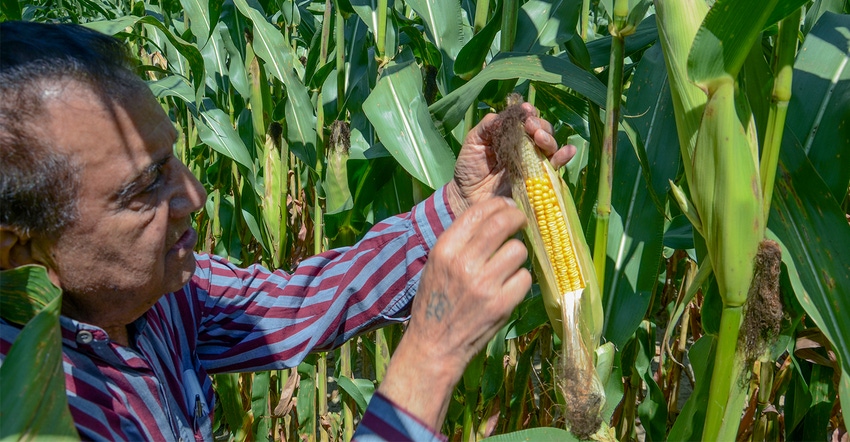
The Corn Watch ’17 field lost yield potential during the first three weeks of August. That’s because the weather turned dry and plants aborted tip kernels. Those tip kernels could have contributed a significant boost to yield, Dave Nanda notes.
“Whenever a plant is stressed at or after pollination, one of the things it can do is abort tip kernels, even if they were already pollinated and developing,” says Nanda, an independent crops consultant based in Indianapolis. Corn Watch ’17 is sponsored by Seed Genetics-Direct, Washington Court House, Ohio.
In this case, dry weather was the primary factor driving kernel abortion, Nanda notes. The field had been blessed with moisture all year — sometimes too much. Then in late July the rainfall stopped, and the field only received a half-inch or less during the next month.
“That’s a critical time for grain fill,” Nanda says. “Once the plant senses stress, it will pull back on the number of kernels it thinks it can make. A plant’s goal is to make as many viable kernels as possible.”
Hybrids differ somewhat in their ability to fill ear tips, and in how quickly or how far back abortion may occur. However, stress is the driver of kernel abortion and tip dieback, he notes.
Other factors, including disease or nutrient deficiencies, can cause or contribute to stress. These also could result in kernel abortion and blank cob at the tips of ears, Nanda says.
Example
Here’s an example comparing yield estimates done after pollination before dry weather took its toll, and then three weeks later, with virtually no rain occurring in the meantime. These are just estimates, using 90 as the factor, representing 90,000 kernels per bushel.
• Before: Average number of ears per 1/1000 acre is 30; rows of kernels per ear is 16; average number of kernels per row is 44.
The math: 30 (16 x 44) = 21,120 / 90 = 235 bushels per acre
• After (first spot): Number of ears is 30; 16 rows of kernels with 40 kernels per row.
The math: 30 (16 x 40) = 19,200 / 90 = 213 bushels per acre
• After (second spot): Number of ears is 30; 16 rows with 36 kernels per row.
The math: 30 (16 x 36) = 17,280 / 90 = 192 bushels per acre
Explanation
The yield estimate dropped from the peak by more than 20 bushels per acre to the first spot checked in the field. It dropped by more than 40 bushels per acre when checked where corn was even more stressed by dry weather.
“This shows how important kernel abortion can be,” Nanda says. “Ear count didn’t change and number of rows per ear didn’t change — those are set much earlier. It’s all about losing kernels. Losing eight kernels per each row on every ear of corn is a lot of kernels!”
About the Author(s)
You May Also Like




